The seven Sanctuary Gardens at RHS Chelsea Flower Show 2023, sponsored by the Newt in Somerset, include gardens from Chelsea veterans such Thomas Hoblyn, Taina Suonio and Kazuyuki Ishihara and first-timers like Martyn Wilson.
What is a Sanctuary Garden at Chelsea?
The Sanctuary gardens at Chelsea are smaller gardens that highlight the benefits of gardening on our wellbeing. Sustainable and wildlife friendly planting is central to each design. Two of the gardens are being sponsored by the grant-giving charity, Project Giving Back.
- Main Show gardens
- Sanctuary gardens
- Chelsea this year is a load of rubbish... in a good way
- RHS Chelsea Flower Show 2023: Medals announced
RHS Chelsea Flower Show 2023 Sanctuary Gardens
The Boodles British Craft Garden
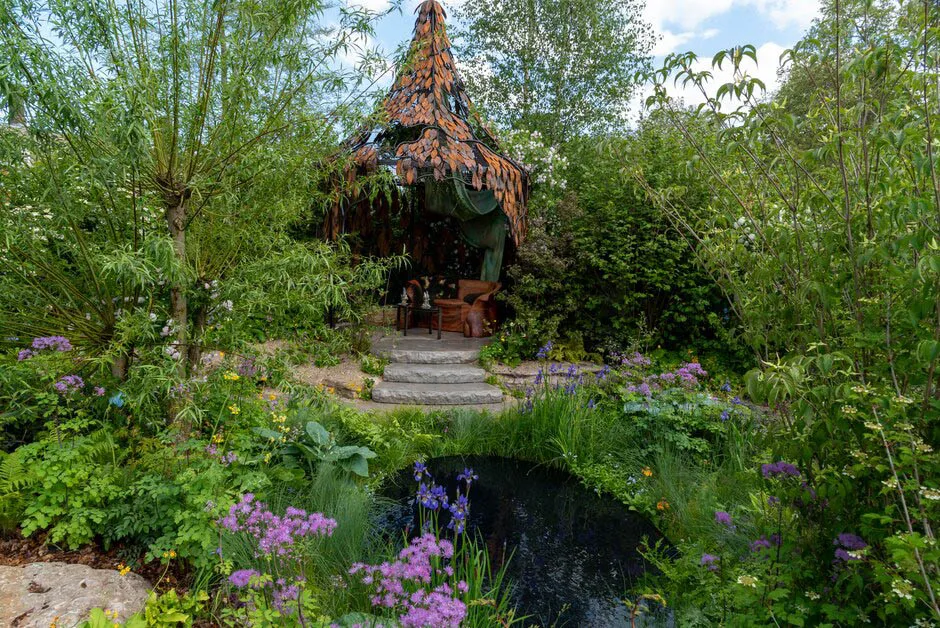
Designer: Thomas Hoblyn
Sponsor: Boodles
Contractor: The Landscaping Consultants
Contact: www.thomashoblyn.com
Tom Hoblyn was inspired by stylised depictions of nature in Pre-Raphaelite paintings for this woodland garden, which celebrates British crafts in many forms. “I love the vibrancy and drama in Pre-Raphaelite paintings; it’s as though they have captured the very essence of Mother Nature and amplified it tenfold,” he explains.
Hoblyn has decided this will be his last Chelsea as a designer: “I’m going to be 60 this year so I want to do other things. I am going out with a bit of a bang this time,” he says. A good moment, then, for Hoblyn to move his plant palette beyond what calls his “normal comfort zone” of a predominantly green palette of ferns. Instead, gold, violet, blue and wine-red flowers thread through the scheme - all inspired by the three colours found in a forget-me-not flower.
There are two main planting zones. First, a wetland meadow around the pool with drifts of grasses including sedges and rushes selected for their refined formed and colours, such as Carex elatior ‘Aurea’. “I have turned up the volume of the colour of everything – a sulphury yellow through to glaucous blue drifts of grasses and grass allies,” he explains. The second area is a more shaded woodland glade with sumptuous flowers such as Lilium ‘Peppard Gold’ and Aquilegia atrata.
The garden is filled with examples of British craft skills, from embroidered cushions adorning the furniture and candlesticks made by Tom's daughter to the garden’s centrepiece, a treelike arbour made from metalwork and cloaked in the double rambling rose Rosa 'Félicité Perpétue’ – loosely inspired by Louise Bourgeois' spider sculptures. “All craftsmanship is taking something from mother nature and refining it and stylising it and perfecting it and that’s what I’ve done with all the elements of the garden,” Hoblyn explains.
The aspect of the garden that has got everyone talking is the water feature, which looks as if rain is dancing on the top of it, designed by Bamber Wallis.
WHAT TO LOOK OUT FOR
1. A metalwork woodland-inspired arbour created by sculptor Chris Cox of Cox London has a branchlike structure and roof tiles made to resemble magnolia leaves.
2. The water feature is a floating pool by water sculptor Bamber Wallis mimics rainfall, with a cycle of raindrops hitting the water’s surface and building to a crescendo as if a storm is passing.
3. Interior designer Rachel Chudley has curated a collection of woodland-inspired furnishings by artisans from all four countries of the UK, including a wooden bench inspired by a tree stump and cushions made from sheeps’ fleece.
4. Jake Catling of contractors The Landscaping Consultants is creating paths using Chatsworth stone, honing them to reveal the fossils within so that they appear as well-worn routes through the garden.
Cavernoma On My Mind
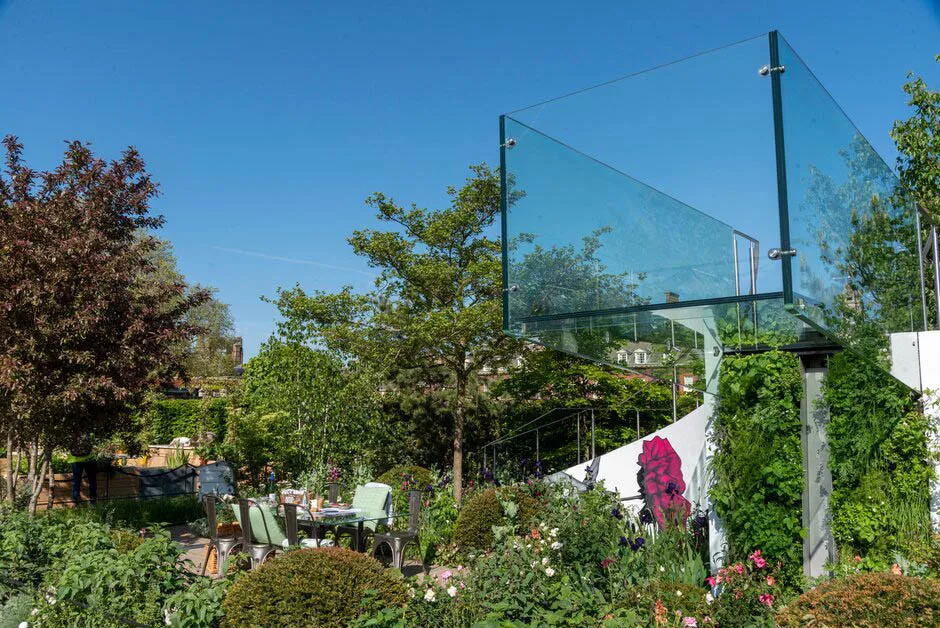
Sponsor: The Cavernoma Society
Designer: Taina Suonio & Anne Hamilton
Contractor: Tom Salmon Landscaping
The Cavernoma On My Mind garden has named areas which describe the feelings of cavernoma patients, such as “fragility of life”,“unconditional love” and “fresh start”. The plants in these named areas have been chosen for the feelings a patient goes through, or for the plants’ healing qualities. The glass steps ascending to the stunning viewing platform symbolise hope for progress and the optimism required for living with the condition. The viewing platform represents security and clarity of vision into the future. The water feature which flows gently down a wall denotes on one hand the tears shed by the patients, and on the other, the calming effect of letting your emotions out. The garden contains plants that have been chosen to symbolise cavernoma, such as Acer griseum, commonly known as blood-bark maple, which represents the thin blood vessels that make up cavernomas, and peonies, whose root extract also has medicinal qualities against epilepsy and seizures.
Hamptons Mediterranean Garden
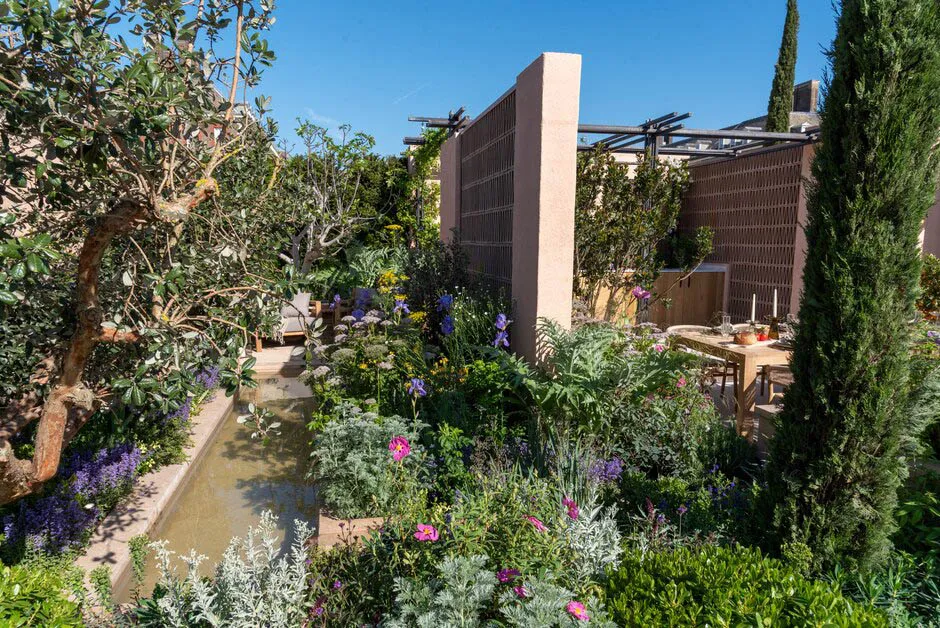
Sponsor: Hamptons
Designer: Filippo Dester
Contractor: Garden Club London
Contact: gadenclublondon.co.uk
Filippo Dester hopes his garden will spark memories of sun-drenched holidays in the Mediterranean, while offering visitors ideas for incorporating more drought-resistant planting in their own outdoor spaces. The central feature is a kitchen and dining area, made intimate by the addition of a pergola. “The garden is very much a room that extends the house outside, a space to be used by people and to be convivial in,” Filippo explains. Conveniently, just a few steps away are a range of edibles to be harvested for the table, including herb fennel and a fig tree.
Each area of the garden demonstrates how the Mediterranean plant palette aesthetic can be applied to different settings: from a raised bed full of drought-tolerant herbaceous flowers at the front of the garden, to clouds of pittosporums in the more shaded spots. “We didn’t want to have a traditional Italian formal garden, but to explain how planting can be done in a conscious way, but a fun way,” Filippo adds.
Water conservation is a central theme, too. “Summers are getting hotter and every year water becomes more and more precious,” Filippo says. Rainwater collected from the garden spills down a wall before travelling along a channel at the front of the garden and coming to rest in a water feature, where it can be used by wildlife and for irrigation. Filippo has designed the water feature to ensure it looks just as good when the water runs dry: a vital consideration as climate change brings us more extremes of heat.
The designer has worked with Groundwork UK to ensure that all elements of the garden will be repurposed and reused once Chelsea is over, creating drought-tolerant displays in local schools.
WHAT TO LOOK OUT FOR
1. An outdoor kitchen and dining area is the garden’s focal point, offering a place for people to gather, eat and drink under a pergola.
2. Mediterranean planting incorporates drought tolerance with opportunities for foraging for food: a pomegranate tree, herbs and other edibles will grow alongside ornamentals such as Pittosporum tobira ‘Nanum’ and cypress trees.
3. An intimate water feature surrounded by screens and dense planting showcases how water can be conserved.
4. An area of gravel planting at the archway entrance to the garden showcases sun-loving succulents, including Agaves and Dasylirions.
5. Arbutus unedo the strawberry tree, which has attractive bark and pretty red fruits as a statement tree.
The London Square Community Garden
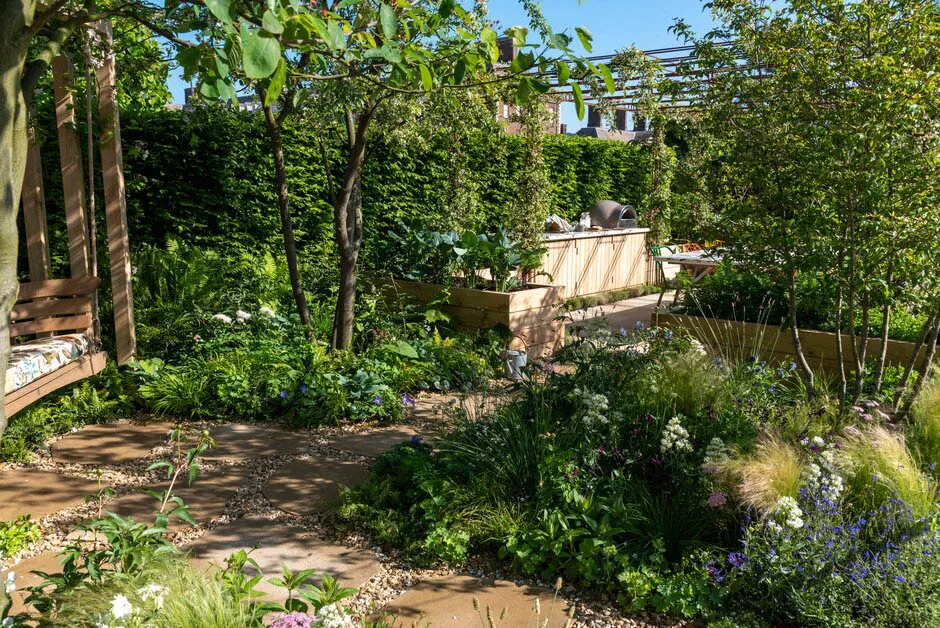
Sponsor: London Square
Designer: James Smith
Contractor: The Landscape Consultants
The garden reflects London Square’s ethos of providing a vital connection between people through communal gardens. This garden represents a place to meet, to share food and to connect with nature and relax. There are two contrasting areas of what would be a larger garden. A welcoming meeting space has a a large communal table and borrowed chairs, and there are areas for growing produce, playing games, or sitting under the shade of a pergola. Planting is a mix of lush green textures with highlights of purple, white, and pink.
The National Brain Appeal’s Rare Space
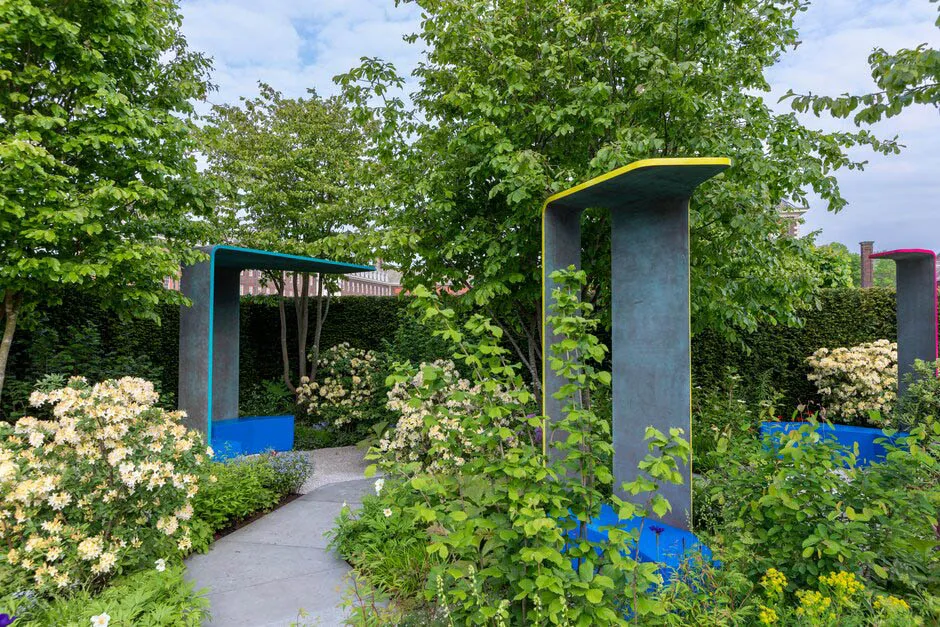
Sponsor: Project Giving Back supporting the National Brain Appeal
Designer: Charlie Hawkes
Contractor: Landscape Associates Ltd
Planting: Hardy's Cottage Garden Plants
Highlighting the work of the National Brain Appeal, supporting those living with rare forms of dementia, Charlie chose to highlight Posterior Cortical Atrophy (PCA), a type of visual dementia where the brain fails to correctly interpret what the eye is seeing - and vision is, as a result, fragmented. “The design came from speaking to doctors, carers and those living with PCA, highlighting the need for physical spaces that have simplicity and clean contrast,” explains Charlie.
Multi-stemmed, umbrella-form Parrotia persica trees have been chosen for their clear visual stance and dense canopy that avoids any confusing dappled light. Simple, solid seating is defined by block colours to provide points of reference to the garden user, while the pathway allows for some autonomy of experience and engagement.
Charlie admits that the bar has been set high following his Gold at last year's show for his Wilderness Foundation UK garden within the All About Plants category. "But I'm excited to be pulled out of my comfort zone and create something that I never would have created for a regular client. It's very different."
WHAT TO LOOK OUT FOR
1: Concrete path – Charlie worked with Specialist Precast Products based in Wales, who he describes as ‘wizards in concrete’. Together they have worked through a number of samples, trying to get a classic concrete look but using 100 per cent recycled aggregates, and 40 per cent of the cement substituted out for a non-concrete material.
2: Dark-stemmed, bronze-leaved planting – such as Thalictrum ‘Black Stockings’, Disporum longistylum ‘Night Heron’ and Rodgersia podophylla ‘Braunlaub’ to give harmony but with a subtle movements towards contrast.
3: Species tulips, Tulipa sprengeri (growing both in England and Scotland in the hope of hitting the flowering moment just right) and iris to give highlights of colour.
4: Water features – Charlie still wanted the sound of water but needed to avoid any visual disorientation of sunlight bouncing off the surface of a pool. Instead, he is using columns of stone with serrated edges down which water gently trickles.
The RSPCA Garden
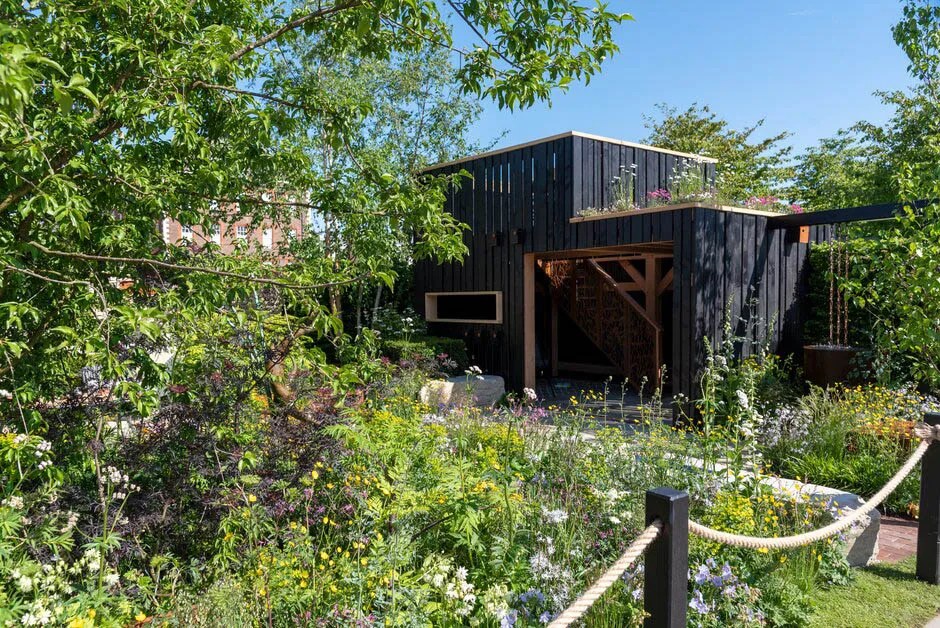
Sponsor: Project Giving Back supporting the RSPCA
Designer: Martyn Wilson
Contractor: Landscape Associates
Designer Martyn Wilson makes his RHS Chelsea debut with a garden that puts a stylish twist on the idea of a wildlife sanctuary. “I am hoping we can open up the concept of introducing wildlife to your garden to a new audience,” says Martyn. “As designers we are quite often asked to create gardens that are low maintenance, but if we want to bring everybody on this journey then we need to cater for different ambitions and desires for people’s spaces.”
The garden incorporates a range of materials chosen for their sustainability, including a laser-cut CorTen steel framework for a ‘dead hedge’ where woody prunings are put to work as a wildlife habitat, and a rill made from recycled plastic. “We are all trying to minimise use of plastic in our gardens, but plastic is here to stay, so if there are other markets for it, we can use it,” Martyn explains. “The way the rill twists and turns through the space is about the journey the animals take when they come into a rescue centre.” It also reflects the fact that many animals rescued by the RSPCA have been trapped in plastic.
Martyn experienced this first hand when he visited the charity’s rescue centre at West Hatch: there were 70 hedgehogs undergoing treatment, and 17 seagulls awaiting release the following day, underlining the huge amount of rescue and rehabilitation work the RSPCA undertakes. “I am hoping there are little vignettes that the viewing public can take home with them, like the idea of nesting boxes set in a feature wall to help sparrows, and bee hotels on the wildlife hide,” says Martyn.
The garden is destined to find a home at the RSPCA’s Stapeley Grange Wildlife Centre and education hub in Cheshire after the show, where it will continue to offer sanctuary for wildlife, as well as providing staff, volunteers and visitors with a place to rest.
WHAT TO LOOK OUT FOR
1. A modern take on a ‘dead hedge’ edged in CorTen steel houses recycled garden prunings and offers valuable habitats for wildlife.
2. A bronze sculpture of otters at play by wildlife artist Simon Gudgeon. The sculptor has loaned this work which was inspired by watching otters in the care of the RSPCA.
3. A wildlife observation hide with a green roof looks out onto the garden and offers home for bees via a series of insect hotels.
4. A ‘rill’ made from colourful recycled plastic represents the journey of rehabilitation and care given to animals rescued by the RSPCA.
5. Hornbeam hedgerows surround the garden and the planting scheme offers a wildlife-friendly scheme of white, green and the blue of the RSPCA logo.
Zen Garden
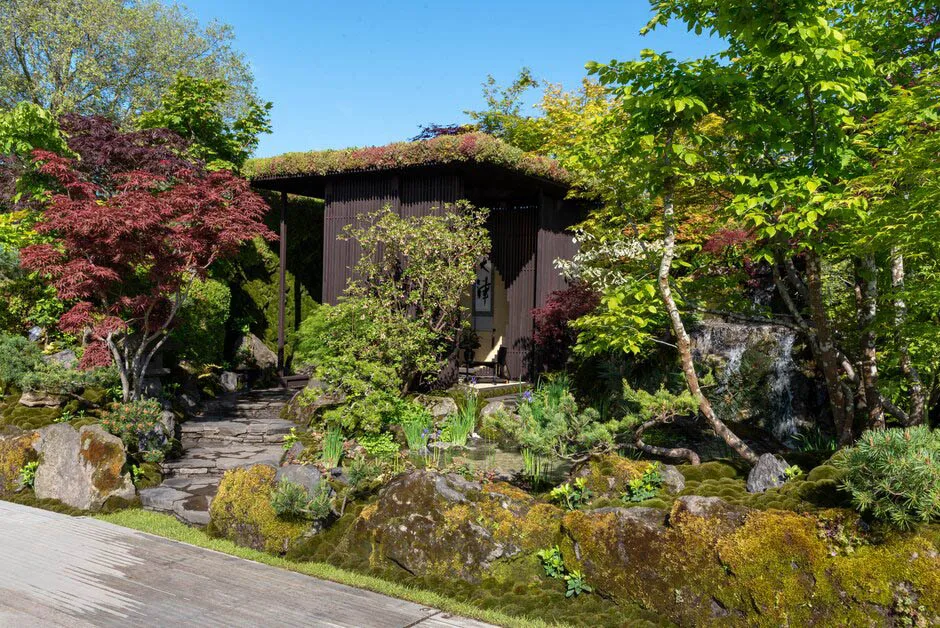
Sponsor: Ishihara Kazuyuki Design Laboratory
Designer: Kazuyuki Ishihara
Contractor: Ishihara Kazuyuki Design Laboratory
Chelsea favourite Kazuyuki Ishihara makes a welcome return to RHS Chelsea in 2023 with a garden inspired by the traditional satoyama landscapes found in the foothills of Japan. This garden is a refreshing place in which to live a simplified life. The water moves yet is quiet as in mountain spring. Surface fluctuations reflect flowers. The simple land area allows enjoyment of the charming rock garden, dry as in the mountains. The Japanese satoyama woodland plants of acer, pine, and mosses feature. The waterside uses watercress, iris, and natural materials that are deeply involved in the spirit of Zen forming a solid base for our spiritual lives.